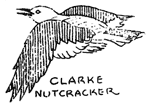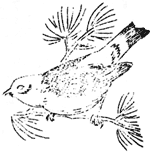We and the Birds – Garfield Peak
By W. Craig Thomas, Ranger-Naturalist
This morning, let us take a stroll up Garfield Peak Already we can hear the songs of birds that have learned better than human beings how to sing at their work.
As we pass the Lodge, going along the rock wall, a wise-looking marmot surveys us with dignity appropriate to his station and slides off the other side of the wall. When we reach the place, however, he has vanished within the rocks. But a sudden sweet song allays what disappointment we may feel.
 It is the tinkle bell song, the thrill of Thurber’s Junco. And then we see him, perched at the very tip of a small tree, sending his lovely thread of song into the surrounding forest. The female is busy gathering tiny insects and seeds in the dense grasses and plants at the foot of the tree. Her nest is carefully hidden under the leaves of the trailing currant, but if we watch we can find it. We notice, also, that her beak is heavy and thick, in order to crack the shells from seeds that she many find. But while we are watching her, we become conscious of another song, the metallic buzz of the Western Chipping Sparrow. And suddenly we see him, perched on the top of a stump in the little meadow. His locust-like song comes thinly across to us, and fearing to frighten him, we stay where we are. But through the glasses, we can see the chestnut patch on the top of his head, and the heavy beak that marks him as another seed-eater.
It is the tinkle bell song, the thrill of Thurber’s Junco. And then we see him, perched at the very tip of a small tree, sending his lovely thread of song into the surrounding forest. The female is busy gathering tiny insects and seeds in the dense grasses and plants at the foot of the tree. Her nest is carefully hidden under the leaves of the trailing currant, but if we watch we can find it. We notice, also, that her beak is heavy and thick, in order to crack the shells from seeds that she many find. But while we are watching her, we become conscious of another song, the metallic buzz of the Western Chipping Sparrow. And suddenly we see him, perched on the top of a stump in the little meadow. His locust-like song comes thinly across to us, and fearing to frighten him, we stay where we are. But through the glasses, we can see the chestnut patch on the top of his head, and the heavy beak that marks him as another seed-eater.
We are rudely interrupted in our bird watching by the raucous cries of some argumentative Clark’s Nutcrackers. In the top of a dead snag, they flaunt their family rows to the whole world which unfortunately is not very interested. And then we see the animated beauty and the dark grey of Allen’s chipmunk. We had seen already the smaller and brighter Klamath chipmunk scurrying near the rim as we started. The golden-mantled ground-squirrel we already also knew as the little beggar of the rocks, forever asking, however silently, for a hand-out.
Then as we go on past the meadow toward the rim and the broken colors of the rock slide, from trees along the path, we hear two songs so much alike that we must listen carefully to detect the difference. One we are sure is the purple finch, Cassin’s in this altitude, and soon we see him, his red head shining against the background of mountain hemlocks. His beak, too, is heavy, so we automatically place him with the junco and the chipping sparrow as a seed-eater. The other song we think comes from the Lincoln sparrow but he is too hard to find in our limited time so we go on up the trail.
But we do not proceed far, when the sudden flash and beauty of yellow and black tells us a Western Tanager has crossed our path on swift wings. As he perches for an instant on the dark green of a hemlock bough, we see clearly the red head, the yellow body, and the black wings and tail of the most beautiful of our western birds. We almost overlook the quiet green of his mate in our admiration of him. Then from the rockslide comes a strange little cry, the almost nasal whistling of the little cony.


